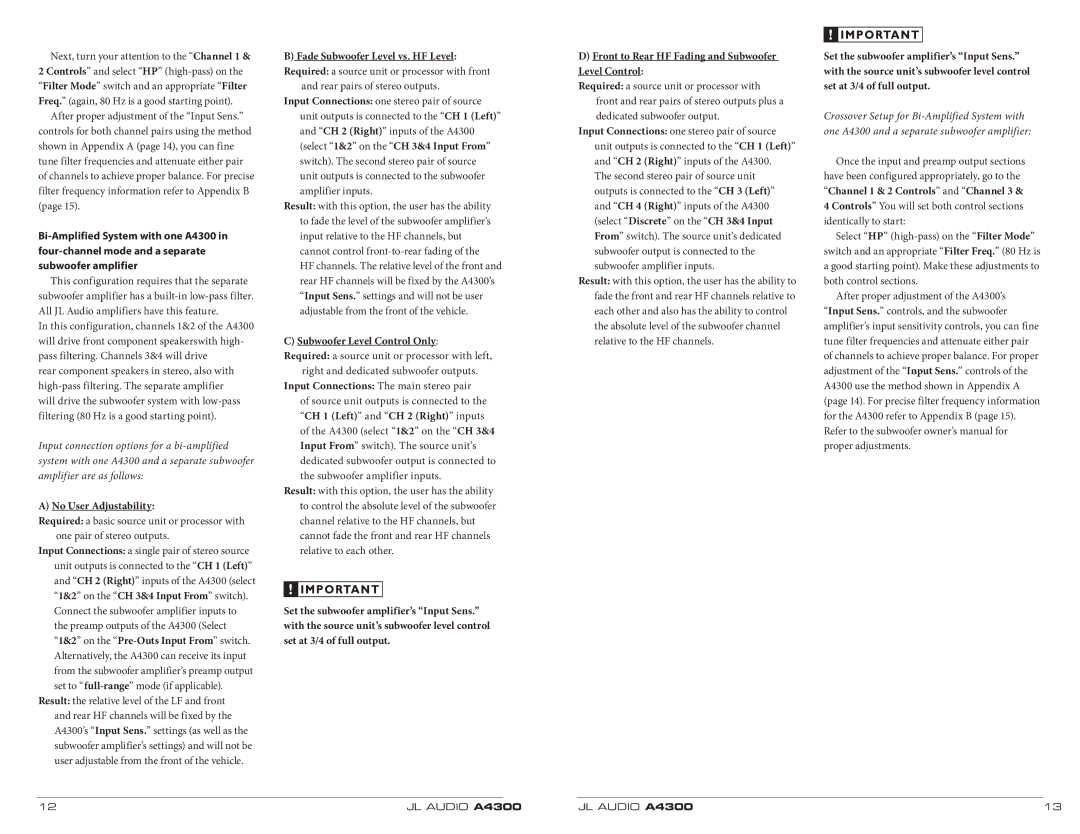
Next, turn your attention to the “Channel 1 & 2 Controls” and select “HP”
After proper adjustment of the “Input Sens.” controls for both channel pairs using the method shown in Appendix A (page 14), you can fine tune filter frequencies and attenuate either pair of channels to achieve proper balance. For precise filter frequency information refer to Appendix B (page 15).
This configuration requires that the separate subwoofer amplifier has a
In this configuration, channels 1&2 of the A4300 will drive front component speakerswith high- pass filtering. Channels 3&4 will drive
rear component speakers in stereo, also with
Input connection options for a
A)No User Adjustability:
Required: a basic source unit or processor with one pair of stereo outputs.
Input Connections: a single pair of stereo source unit outputs is connected to the “CH 1 (Left)” and “CH 2 (Right)” inputs of the A4300 (select “1&2” on the “CH 3&4 Input From” switch).
Connect the subwoofer amplifier inputs to the preamp outputs of the A4300 (Select “1&2” on the
Result: the relative level of the LF and front and rear HF channels will be fixed by the A4300’s “Input Sens.” settings (as well as the subwoofer amplifier’s settings) and will not be user adjustable from the front of the vehicle.
B)Fade Subwoofer Level vs. HF Level: Required: a source unit or processor with front
and rear pairs of stereo outputs.
Input Connections: one stereo pair of source unit outputs is connected to the “CH 1 (Left)” and “CH 2 (Right)” inputs of the A4300 (select “1&2” on the “CH 3&4 Input From” switch). The second stereo pair of source unit outputs is connected to the subwoofer amplifier inputs.
Result: with this option, the user has the ability to fade the level of the subwoofer amplifier’s input relative to the HF channels, but cannot control
C)Subwoofer Level Control Only:
Required: a source unit or processor with left, right and dedicated subwoofer outputs.
Input Connections: The main stereo pair of source unit outputs is connected to the “CH 1 (Left)” and “CH 2 (Right)” inputs
of the A4300 (select “1&2” on the “CH 3&4 Input From” switch). The source unit’s dedicated subwoofer output is connected to the subwoofer amplifier inputs.
Result: with this option, the user has the ability to control the absolute level of the subwoofer channel relative to the HF channels, but cannot fade the front and rear HF channels relative to each other.
Set the subwoofer amplifier’s “Input Sens.” with the source unit’s subwoofer level control set at 3/4 of full output.
D)Front to Rear HF Fading and Subwoofer Level Control:
Required: a source unit or processor with front and rear pairs of stereo outputs plus a dedicated subwoofer output.
Input Connections: one stereo pair of source unit outputs is connected to the “CH 1 (Left)” and “CH 2 (Right)” inputs of the A4300.
The second stereo pair of source unit outputs is connected to the “CH 3 (Left)” and “CH 4 (Right)” inputs of the A4300 (select “Discrete” on the “CH 3&4 Input From” switch). The source unit’s dedicated subwoofer output is connected to the subwoofer amplifier inputs.
Result: with this option, the user has the ability to fade the front and rear HF channels relative to each other and also has the ability to control the absolute level of the subwoofer channel relative to the HF channels.
Set the subwoofer amplifier’s “Input Sens.” with the source unit’s subwoofer level control set at 3/4 of full output.
Crossover Setup for
Once the input and preamp output sections have been configured appropriately, go to the “Channel 1 & 2 Controls” and “Channel 3 &
4 Controls” You will set both control sections identically to start:
Select “HP”
After proper adjustment of the A4300’s “Input Sens.” controls, and the subwoofer amplifier’s input sensitivity controls, you can fine tune filter frequencies and attenuate either pair of channels to achieve proper balance. For proper adjustment of the “Input Sens.” controls of the A4300 use the method shown in Appendix A (page 14). For precise filter frequency information for the A4300 refer to Appendix B (page 15). Refer to the subwoofer owner’s manual for proper adjustments.
12 | JL AUDIO A4300 | JL AUDIO A4300 | 13 |
